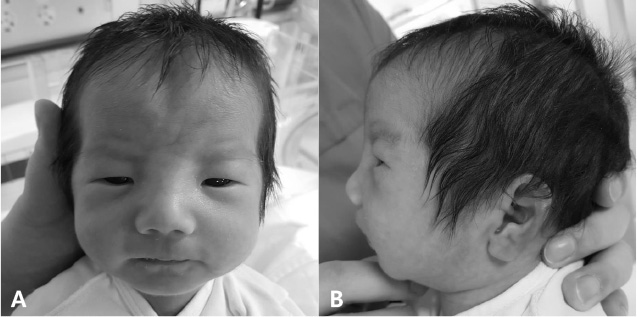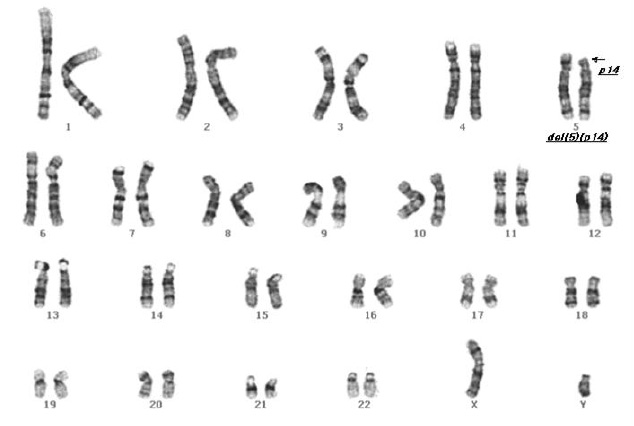Perinatology.
2018 Mar;29(1):48-51. 10.14734/PN.2018.29.1.48.
Cri-du-chat Syndrome with Dysphagia
- Affiliations
-
- 1Department of Pediatrics, Presbyterian Medical Center, Jeonju, Korea. soriyh@nate.com
- 2Department of Laboratory Medicine, Presbyterian Medical Center, Jeonju, Korea.
- KMID: 2409112
- DOI: http://doi.org/10.14734/PN.2018.29.1.48
Abstract
- The cri-du-chat syndrome is a chromosomal disease caused by a deletion on the short arm of chromosome 5. Clinical features are characteristic facial features and high pitched cat like cry, various malformations, complications, dysphagia, and feeding difficulties. There have been several reports of cri-du-chat syndrome in Korea, but no case reports about the patients with cri-du-chat syndrome with dysphagia who underwent percutaneous endoscopic gastroenterotomy (PEG) have been reported. Therefore, we report a case of cri-du-chat syndrome with sustained dysphagia who underwent PEG for long term enteral nutrition with a review of the literatures.
Keyword
MeSH Terms
Figure
Reference
-
1. Ahn HS, Shin HY. Genetics, in Textbook of pediatrics. 11th ed. Seoul: MiraeN;2016. p. 144–145.2. Lejeune J, Lafourcade J, Berger R, Vialatte J, Boeswillwald M, Seringe P, et al. Trois cas de délétion partielle de bras court d`un chromosome 5. CR Acad Sci. 1963; 257:3098–3102.3. Kim CH, Jo EH, Shin SM, Kim JS. A case of cat cry syndrome. J Korean Pediatr Soc. 1975; 18:44–48.4. Gardner RJM, Sutherland GR, Shaffer LG. Chromosome abnormalities and genetic counseling. 4th ed. New York: Oxford University Press;2012. p. 313.5. Nguyen JM, Qualmann KJ, Okashah R, Reilly A, Alexeyev MF, Campbell DJ. 5p deletions: current knowledge and future directions. Am J Med Genet C Semin Med Genet. 2015; 169:224–238.
Article6. Mainardi PC, Pastore G, Castronovo C, Godi M, Guala A, Tamiazzo S, et al. The natural history of Cri du Chat Syndrome. A report from the Italian register. Eur J Med Genet. 2006; 49:363–383.7. Cornish KM, Pigram J. Developmental and behavioural characteristics of cri du chat syndrome. Arch Dis Child. 1996; 75:448–450.
Article8. Niebuhr E. Cytologic observations in 35 individuals with a 5p- karyotype. Hum Genet. 1978; 42:143–156.
Article9. Löser C, Aschl G, Hébuterne X, Mathus-Vliegen EM, Muscaritoli M, Niv Y, et al. ESPEN guidelines on artificial enteral nutrition—percutaneous endoscopic gastrostomy (PEG). Clin Nutr. 2005; 24:848–861.10. ASPEN Board of Directors and the Clinical Guidelines Task Force. Guidelines for the use of parenteral and enteral nutrition in adult and pediatric patients. JPEN J Parenter Enteral Nutr. 2002; 26:1 Suppl. 1SA–138SA.11. Kirby DF, Delegge MH, Fleming CR. American Gastroenterological Association technical review on tube feeding for enteral nutrition. Gastroenterology. 1995; 108:1282–1301.
Article12. El-Matary W. Percutaneous endoscopic gastrostomy in children. Can J Gastroenterol. 2008; 22:993–998.
Article13. Niebuhr E. The cri du chat syndrome: epidemiology, cytogenetics, and clinical features. Hum Genet. 1978; 44:227–275.14. Gauderer MW, Ponsky JL, Izant RJ Jr. Gastrostomy without laparotomy: a percutaneous endoscopic technique. J Pediatr Surg. 1980; 15:872–875.
Article15. Park RH, Allison MC, Lang J, Spence E, Morris AJ, Danesh BJ, et al. Randomised comparison of percutaneous endoscopic gastrostomy and nasogastric tube feeding in patients with persisting neurological dysphagia. BMJ. 1992; 304:1406–1409.
Article16. Hahn SJ, Lim YJ, Yang CH, Lee JH. Satisfaction survey of care providers for enteral feeding by the use of percutaneous endoscopic gastrostomy. Korean J Gastrointest Endosc. 2009; 39:8–13.




